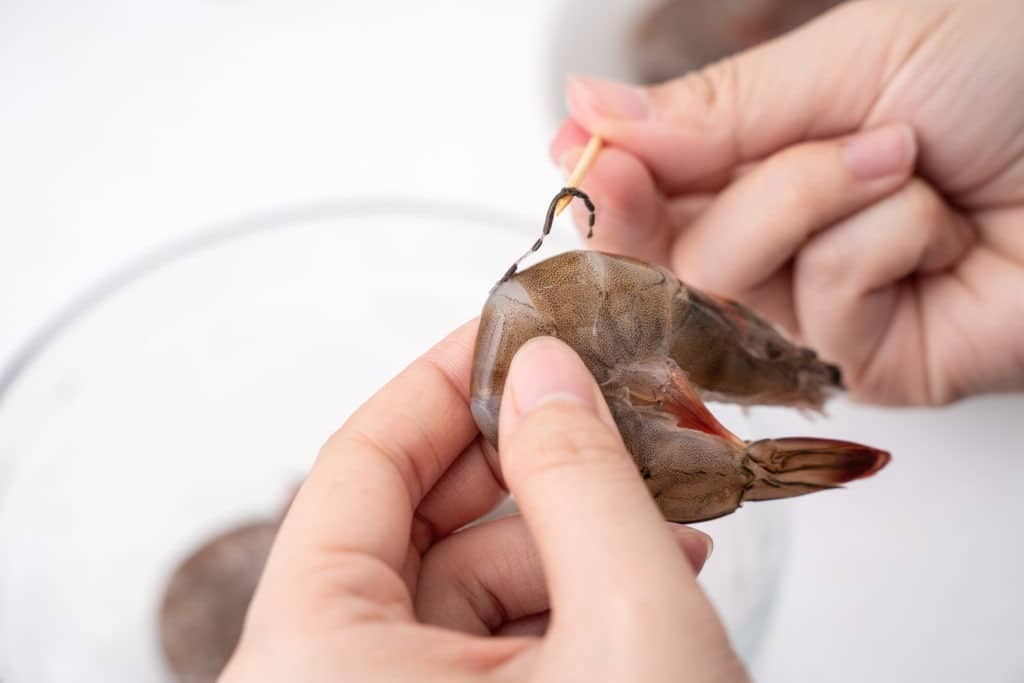The black line on the top of a shrimp is its digestive tract, so yes, that’s poop you can see. It’s safe to eat, but in general people tend to prefer their shrimp deveined, i.e. with the digestive tract removed, because the tract can have a bitter taste and a sandy texture.

To Devein or Not to Devein
The decision to devein shrimp is basically a matter of personal preference and aesthetics, not hygiene, and the vein is not harmful to the human body if eaten.
If the vein is visible through the shell and meat, and if you find the digestive tract unappealing and unattractive, then it makes sense to remove it. (In some countries, like Japan, they serve the shrimp with the visible vein.) With large shrimp, it is fairly easy to devein them: Use a sharp paring knife to make a slit along the back and lift out the vein with the tip of the knife.
Most cooks will not bother deveining medium-sized or smaller shrimp unless they look particularly dirty. Small shrimp are more challenging; it could take hours to go through the deveining process for numerous shrimp. To make cooks lives easier, many suppliers offer deveined shrimp, which is sometimes done without splitting the flesh or even removing the shell. So if deveining is not for you, try to find pre-packed frozen deveined shrimp. Whether you devein or not, its a good idea to wash your hands—and any utensils that came into contact with the shrimp—in hot, soapy water. Shrimp harbor bacteria that could, if spread, cause food poisoning.
Shelling the Body and the Tail
In some instances, its OK to leave the shell on during cooking. For example, when grilling shrimp its wise to leave the shell on because it protects the meat from the intense heat of the grill. Peel-and-eat shrimp, as the name suggests, is another example of when you would leave the shell on. But for other dishes, such as a stir-fry or shrimp scampi, or a shrimp cocktail appetizer, you should go the extra step of removing the shell so you can dig in right away and enjoy the food. It is simple enough to peel the shell off of the body of the shrimp, but removing the shell over the tail takes a little bit of finesse—too forceful and you will pull that tail right off, losing precious meat.
You can leave the tail on in dishes where it is obvious and conspicuous, so diners can remove it themselves. However, in recipes where a heavy sauce may disguise the tail, you should remove it rather than surprising a guest with an unexpected crunchy bite. If you are frying the shrimp leave it on—some people actually enjoy eating the tail when it is deep-fried and crunchy.
- U.S. Food & Drug Administration. Selecting and serving fresh and frozen seafood safely. Updated Oct. 28, 2021.
Is the vein in shrimp poop?
FAQ
Is it okay to eat the black stuff in shrimp?
Are you supposed to clean the poop out of shrimp?
What are the black bits in shrimp?
Can you eat shrimp without deveining?
Why are there black lines in shrimp poop?
There are black lines in shrimps commonly referred to as the veins. The simple truth is that these lines are, in fact, not veins but digestive tracts containing shrimp poop. Shrimp poop is often removed from the crustacean in a process called deveining. This deveining happens because many believe consuming the veins is harmful or dirty.
What could be the cause of black unformed stool?
Black or tarry stools may be due to bleeding in the upper part of the GI (gastrointestinal) tract, such as the esophagus, stomach, or the first part of the small intestine. In this case, blood is darker because it gets digested on its way through the GI tract.
What is the black stuff on a shrimp?
The marking is made up of the shellfish’s stomach, midgut, and intestine. Those structures support the crustacean’s digestive process, so yes, that black stuff is the shrimp’s waste, she says. As for what you’re actually seeing there?
Why is shrimp poop white?
The shrimp’s blood vessel consisting of arteries lies on the inside of the shrimp and is a white line, not black. The line is white because shrimps have clear blood and are not red like most animals. So, the process of deveining does not remove the veins, but it eliminates the poop. What other interesting facts about shrimp poop are noteworthy?
